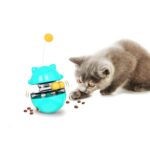If you’re a cat owner, you know that our furry friends can sometimes leave less-than-pleasant surprises in their wake. One of the most common—and frustrating—issues many cat lovers face is the unmistakable smell of cat urine permeating their homes. Whether it’s an accident, marking behavior, or lingering odors from previous mishaps, the scent can be stubborn and overwhelming. But don’t despair!
In this article, we’ll explore effective strategies to eliminate those pesky odors and restore freshness to your living space. From practical cleaning solutions to preventive measures, we’ve got you covered, so you can focus on enjoying the companionship of your feline friend without the unwelcome aroma. Let’s dive into some tried-and-true tips that will help you reclaim your home!
Table of Contents
- Understanding the Causes of Cat Urine Odor
- Effective Cleaning Techniques for Cat Pee Stains
- Choosing the Right Products for Odor Elimination
- Preventing Future Incidents and Maintaining a Fresh Home
- Q&A
- To Conclude

Understanding the Causes of Cat Urine Odor
Cat urine odor can be a persistent and unpleasant challenge for many pet owners, often linked to various factors related to your feline friend’s health, behavior, or environment. Understanding these causes is crucial for effective odor management. Common reasons for the odor include:
Marking Territory: Cats have a natural instinct to mark their territory, and urine is one way they do this, potentially leading to odor issues.
Health Issues: Conditions such as urinary tract infections or diabetes can cause your cat to urinate more frequently or inappropriately, resulting in strong odors.
Improper Litter Box Maintenance: If the litter box is not cleaned regularly, accumulated waste can produce unpleasant smells that linger throughout your home.
Diet: A poor diet or specific ingredients in cat food can also contribute to a stronger urine odor.
Addressing the causes of these odors often requires a multi-faceted approach. Here’s a simple reference table to help identify potential solutions based on the cause:
| Cause | Potential Solution |
|---|---|
| Marking Territory | Provide multiple litter boxes and enrichment activities. |
| Health Issues | Consult a veterinarian for diagnosis and treatment. |
| Improper Maintenance | Clean the litter box daily and replace litter regularly. |
| Diet | Switch to high-quality cat food and monitor hydration. |
Effective Cleaning Techniques for Cat Pee Stains
Dealing with cat pee stains requires a strategic approach to ensure both the stain and odor are completely eliminated. Start by gently blotting the affected area with a clean, dry cloth to absorb as much moisture as possible. Avoid rubbing, as this can spread the stain further. Next, you can use an enzymatic cleaner specifically designed for pet messes. These cleaners break down the proteins in urine, effectively neutralizing odors. Here’s a quick list of materials that can help:
Enzymatic cleaner – Breaks down urine components.
White vinegar – Natural deodorizer that can neutralize odors.
Baking soda – Absorbs moisture and odors.
Hydrogen peroxide – Disinfects and lightens stains.
After treating the area, consider using a homemade cleaning solution. Mix equal parts of water and white vinegar in a spray bottle, then apply it to the stained area. Let it sit for a few minutes before blotting again. Following this, sprinkle baking soda over the area and allow it to sit overnight. This additional step will help absorb any lingering odors. Once dry, vacuum the area to remove any residue. For stubborn stains, repeat the process as needed, and remember to keep your cat’s litter box clean to prevent future accidents.
Choosing the Right Products for Odor Elimination
When it comes to tackling stubborn odors, especially those caused by pets, not all products are created equal. Opt for enzymatic cleaners, which break down the compounds in urine that cause lingering smells. These cleaners are specifically formulated to target pet stains and odors, making them more effective than conventional cleaners. Additionally, look for products that are labeled as natural or eco-friendly; they typically contain fewer harsh chemicals, making them safer for your home and family.
Consider investing in odor-neutralizing agents such as baking soda or activated charcoal. These options are not only affordable but also highly effective in absorbing unpleasant smells. For a more advanced solution, explore air purifiers equipped with HEPA filters that can capture pet dander and odors, significantly improving your indoor air quality. Here’s a quick overview of some popular options:
| Product Type | Benefits |
|---|---|
| Enzymatic Cleaner | Breaks down urine odor compounds |
| Baking Soda | Natural odor absorber, budget-friendly |
| Activated Charcoal | Highly effective at neutralizing odors |
| Air Purifier | Improves air quality, reduces pet dander |
Preventing Future Incidents and Maintaining a Fresh Home
Once you’ve tackled the unpleasant odors, it’s essential to implement strategies that will prevent future incidents. Regular cleaning is key; ensure that litter boxes are scooped daily and cleaned thoroughly at least once a week. Investing in high-quality litter can also make a significant difference, as some options are specifically designed to control odors effectively. Here are some extra tips to keep your home smelling fresh:
- Use enclosed litter boxes to contain smells.
- Place odor-absorbing products like baking soda around your home.
- Maintain fresh air circulation by opening windows regularly.
- Incorporate house plants known for purifying air, such as peace lilies or spider plants.
In addition to these preventive measures, monitoring your cat’s health is vital. Sudden changes in litter box habits may indicate underlying health issues, so keep an eye on your furry friend and consult a vet if necessary. Regular vet check-ups not only ensure your pet’s well-being but also contribute to a more harmonious home environment. Consider engaging in playtime activities to encourage your cat to use the litter box properly. Here’s a simple table summarizing the cat care tips:
| Tip | Description |
|---|---|
| Regular Cleaning | Scoop litter daily and clean weekly. |
| Quality Litter | Invest in odor-controlling litter. |
| Vet Check-ups | Monitor health for behavioral changes. |
| Playtime | Engage your cat to encourage proper habits. |
Q&A
Q: Why does my house smell like cat pee?
A: Cat urine has a strong and distinct odor, often due to the presence of ammonia, which can be particularly pungent. Common reasons for this smell include a cat marking its territory, issues with litter box cleanliness, or even a health issue with your cat. Older cats may have incontinence or may not be able to reach the litter box in time.
Q: How can I determine the source of the smell?
A: Start by checking common areas where your cat may have urinated, such as around the litter box, on carpets, or near furniture. If the urine smell is strong, consider using a black light to locate any hidden spots, as cat urine glows under UV light.
Q: What are some effective ways to clean cat urine?
A: The key is to clean the area immediately to prevent lingering smells. First, blot any fresh urine with paper towels. Then, use a solution of equal parts white vinegar and water, or a commercial enzyme-based cleaner specifically designed for pet stains. Avoid ammonia-based cleaners, as they can reinforce the smell.
Q: Are there any home remedies to eliminate cat pee odors?
A: Yes! Beyond vinegar, baking soda is an excellent deodorizer. After cleaning the area, sprinkle baking soda over it and let it sit for several hours before vacuuming. You can also try hydrogen peroxide mixed with dish soap and baking soda for tough stains.
Q: Will using air fresheners or sprays solve the problem?
A: While air fresheners can mask the smell temporarily, they won’t eliminate the odor source. It’s essential to thoroughly clean the affected area first, or else the smell will likely return.
Q: How can I prevent my cat from urinating outside the litter box?
A: Ensure the litter box is clean, accessible, and placed in a quiet, low-traffic area. You may need to try different types of litter or boxes to find what your cat prefers. Additionally, if your cat exhibits unusual urination behavior, consult a veterinarian to rule out any medical issues.
Q: What if the smell persists despite cleaning?
A: If you’ve thoroughly cleaned and the odor remains, it may have seeped into deeper materials like carpets or floorboards. In such cases, consider hiring a professional cleaning service that specializes in pet odor removal or using a steam cleaner to penetrate deeper layers.
Q: Is there anything I should avoid when trying to eliminate cat urine odors?
A: Yes, avoid ammonia-based cleaners, as they can actually exacerbate the smell. Additionally, refrain from using strong-scented products that can irritate your cat or mask the underlying problem without addressing it.
Q: When should I consult a professional?
A: If you’ve tried various cleaning methods and the smell persists, or if your cat continues to urinate outside the litter box, it’s a good idea to consult both a professional cleaner and your veterinarian for further advice and assistance.
By taking these steps, you can tackle the cat pee odor in your home and create a fresh, clean environment for both you and your furry friend!
To Conclude
dealing with unpleasant odors like cat pee can be a daunting task for any pet owner, but with the right strategies and tools, you can reclaim your home and make it fresh again. By understanding the sources of the smell and employing effective cleaning techniques, you can not only eliminate odors but also create a more inviting environment for both you and your furry friends. Remember to take a proactive approach by addressing any accidents promptly and ensuring your cat has a clean litter box. With patience and a little effort, you can enjoy a pleasant-smelling home while keeping your beloved pet happy and healthy. Don’t hesitate to share your own tips and experiences in the comments below – we’re all in this together on our journey to a fresher home! Happy cleaning!















